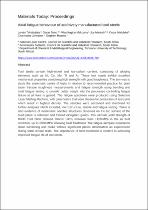JavaScript is disabled for your browser. Some features of this site may not work without it.
- ResearchSpace
- →
- Research Publications/Outputs
- →
- Journal Articles
- →
- View Item
| dc.contributor.author |
Tshabalala, Lerato C

|
|
| dc.contributor.author |
Sono, Oscar JH

|
|
| dc.contributor.author |
Makoana, Nkutwane W

|
|
| dc.contributor.author |
Masindi, J

|
|
| dc.contributor.author |
Maluleke, O

|
|
| dc.contributor.author |
Johnston, C

|
|
| dc.contributor.author |
Masete, Mosimanegape S

|
|
| dc.date.accessioned | 2020-09-14T19:00:06Z | |
| dc.date.available | 2020-09-14T19:00:06Z | |
| dc.date.issued | 2020-06 | |
| dc.identifier.citation | Tshabalala, L.C., Sono, O.J.H., Makoana, N.W., et al. 2020. Axial fatigue behaviour of additively manufactured tool steels. Materials Today: Proceedings, https://doi.org/10.1016/j.matpr.2020.04.548 | en_US |
| dc.identifier.issn | 2214-7853 | |
| dc.identifier.uri | https://doi.org/10.1016/j.matpr.2020.04.548 | |
| dc.identifier.uri | https://www.sciencedirect.com/science/article/pii/S2214785320331709 | |
| dc.identifier.uri | http://hdl.handle.net/10204/11582 | |
| dc.description | Copyright: 2019, Elsevier. Due to copyright restrictions, the attached PDF file contains the abstract of the full-text item. For access to the full-text item, please consult the publisher's website: https://doi.org/10.1016/j.matpr.2020.04.548 | en_US |
| dc.description.abstract | Tool steels contain high-nickel and low-carbon content, consisting of alloying elements such as Ni, Co, Mo, Ti and Al. These tool steels exhibit excellent mechanical properties combining high strength with good toughness. The aim was to study the systematic series of tests in relation to recommended practice for plain strain fracture toughness measurements and fatigue strength using bending and axial fatigue testing to provide better insight insight into the processes controlling fatigue failure at all lives is gained. The fatigue specimen were produced using Selective Laser Melting Machine, with parameters that were chosen for production of test parts which result in highest density. The samples were sectioned and machined for further analyses which included, microstructure, tensile and fatigue testing. There is also evidence of martensitic needles structures observed on the top surface of the build plane is coherent and formed elongated grains. The ultimate yield strength of M300 Tool Steel showed almost 100% increase from 1100 MPa in the as built condition, up to 2050 MPa following heat treatment. The fatigue samples experience strain hardening and broke without significant plastic deformation as experienced during static tensile tests. The importance of heat treatment is evident in achieving improved fatigue life of tool steels. | en_US |
| dc.language.iso | en | en_US |
| dc.publisher | Elsevier | en_US |
| dc.relation.ispartofseries | Workflow;23666 | |
| dc.subject | Additive manufacturing | en_US |
| dc.subject | Fatigue | en_US |
| dc.subject | Heat treatment | en_US |
| dc.subject | M300 tool steel | en_US |
| dc.subject | Selective laser melting | en_US |
| dc.title | Axial fatigue behaviour of additively manufactured tool steels | en_US |
| dc.type | Article | en_US |
| dc.identifier.apacitation | Tshabalala, L. C., Sono, O. J., Makoana, N. W., Masindi, J., Maluleke, O., Johnston, C., & Masete, S. (2020). Axial fatigue behaviour of additively manufactured tool steels. http://hdl.handle.net/10204/11582 | en_ZA |
| dc.identifier.chicagocitation | Tshabalala, Lerato C, Oscar JH Sono, Nkutwane W Makoana, J Masindi, O Maluleke, C Johnston, and S Masete "Axial fatigue behaviour of additively manufactured tool steels." (2020) http://hdl.handle.net/10204/11582 | en_ZA |
| dc.identifier.vancouvercitation | Tshabalala LC, Sono OJ, Makoana NW, Masindi J, Maluleke O, Johnston C, et al. Axial fatigue behaviour of additively manufactured tool steels. 2020; http://hdl.handle.net/10204/11582. | en_ZA |
| dc.identifier.ris | TY - Article AU - Tshabalala, Lerato C AU - Sono, Oscar JH AU - Makoana, Nkutwane W AU - Masindi, J AU - Maluleke, O AU - Johnston, C AU - Masete, S AB - Tool steels contain high-nickel and low-carbon content, consisting of alloying elements such as Ni, Co, Mo, Ti and Al. These tool steels exhibit excellent mechanical properties combining high strength with good toughness. The aim was to study the systematic series of tests in relation to recommended practice for plain strain fracture toughness measurements and fatigue strength using bending and axial fatigue testing to provide better insight insight into the processes controlling fatigue failure at all lives is gained. The fatigue specimen were produced using Selective Laser Melting Machine, with parameters that were chosen for production of test parts which result in highest density. The samples were sectioned and machined for further analyses which included, microstructure, tensile and fatigue testing. There is also evidence of martensitic needles structures observed on the top surface of the build plane is coherent and formed elongated grains. The ultimate yield strength of M300 Tool Steel showed almost 100% increase from 1100 MPa in the as built condition, up to 2050 MPa following heat treatment. The fatigue samples experience strain hardening and broke without significant plastic deformation as experienced during static tensile tests. The importance of heat treatment is evident in achieving improved fatigue life of tool steels. DA - 2020-06 DB - ResearchSpace DP - CSIR KW - Additive manufacturing KW - Fatigue KW - Heat treatment KW - M300 tool steel KW - Selective laser melting LK - https://researchspace.csir.co.za PY - 2020 SM - 2214-7853 T1 - Axial fatigue behaviour of additively manufactured tool steels TI - Axial fatigue behaviour of additively manufactured tool steels UR - http://hdl.handle.net/10204/11582 ER - | en_ZA |






